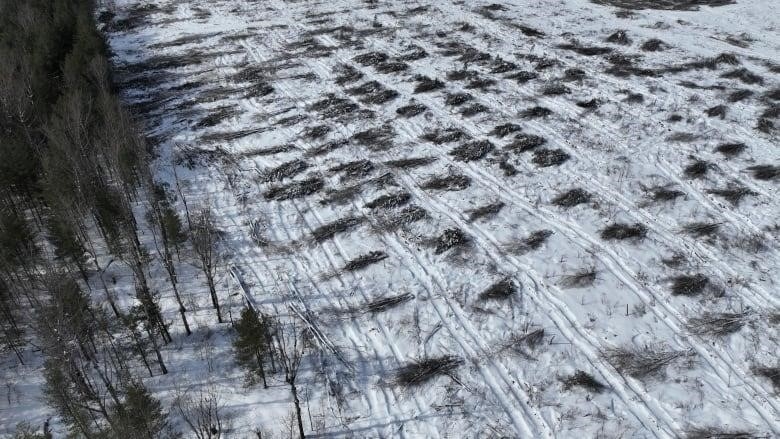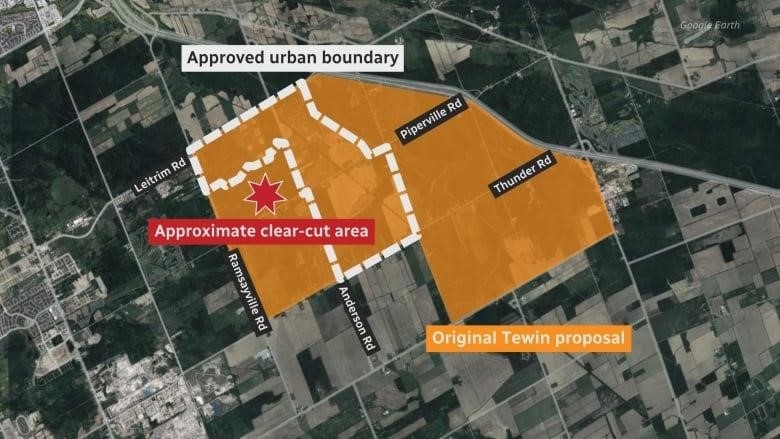
The city staff is happy that the paperwork shows plans to farm land that was once proposed as a suburb
On a huge, partially cleared parcel in rural southeast Ottawa, tree cutting is expected to start up again. This is because city workers decided that the partners behind the future suburb of Tewin did not need a tree permit because they plan to farm the land.
The Algonquins of Ontario (AOO) own a large piece of land north of Piperville Road. According to a memo sent to city council by Don Herweyer, general manager of planning, real estate, and economic development, the City of Ottawa will lift a stop-work order on Tuesday so that trees can be cut down there.
- Neighbors are shocked that Tewin lands are being “deforested.”
- The clear-cutting of Tewin needs to be explained, says the head of the committee.
Herweyer wrote about the area where the Algonquins of Ontario and Taggart Group had proposed plans for a sustainable suburb: “The ownership group has said that the land is being cleared and made ready for farming.” “The ownership group has given the city staff the necessary paperwork in this area.”
CBC asked Herweyer on Tuesday morning what date Taggart and the AOO said they wanted to farm that land, to make sure that it was before the tree-cutting that residents say started more than a month ago. He said he couldn’t remember the date, but he did say that a preliminary lease agreement with an agricultural operation had been submitted. This agreement talked about tiling the land.
Tile-draining is a method used in farming to get rid of too much water below the surface.
In Herweyer’s memo, it says that the property is zoned for farming. It is zoned “rural countryside,” and it is also marked on city maps as an “unevaluated wetland.” This means that it does not have a formal provincial designation that would require a conservation authority to regulate it.
A neighbor and CBC News both got drone footage showing that dozens of hectares of trees have already been cut down and logs are being hauled away. The City of Ottawa had already said that staff were told on February 17, after most of the trees had already been cut down.
At first, people couldn’t see the work going on behind the trees by the road, and they were upset that no one told them it was going to happen. After hearing heavy machinery working in the middle of the night and seeing big trucks carrying logs on their country roads, they had to figure things out on their own. When they first asked, in the middle of February, they were told that the area was being cleaned up after the derecho storm.
Farming practices that don’t coun
One of the few exceptions to the city’s tree protection bylaw, which went into effect in January 2021 to protect the tree canopy in Ottawa, is farming.
Even though the bylaw mostly applies to urban areas, it also covers some land just outside the new urban boundary where the city plans to build new suburbs in the future, including at Tewin. The bylaw says that anyone who cuts down a 10-centimeter-diameter tree without a permit can be fined as much as they want.

In his memo, Herweyer explained that a tree permit is not needed when “the damage or destruction is a normal farm practice carried out by a farming business as part of an agricultural operation.”
He also brought up Ontario’s Farming and Food Protection Act, which says that “no municipal bylaw applies to restrict a normal farm practice carried out as part of an agricultural operation.”
The city will watch the land in the future
CBC News asked Chief Wendy Jocko about the clearcutting on February 27. In her email answer, she said that the area had been used for farming several decades ago, but she didn’t say anything about plans for the future. Instead, she said that cutting down the trees was a necessary part of cleaning up after the derecho storm in May.
Jocko is the leader of the Algonquins of the Pikwakanagan First Nation. This is the only federally recognized First Nation in the Algonquins of Ontario organization, which was set up to negotiate a land claim. This is a separate process from the Tewin development. Many other Algonquin chiefs and elders don’t recognize the AOO and are against both the land claim and the Tewin development.
On February 28, Michelle Taggart of Taggart Group told CBC News that the company had been told that bylaws allowed trees to be cut down in order to make the rural area ready for farming.
In Herweyer’s memo, it says that “the ownership group is responsible for maintaining an exemption under the bylaw” and that the city will keep an eye on what’s going on at the property to “confirm compliance with the farming exemption.”
- After Tewin’s drone footage was made public, logs were still being hauled at midnight.
CBC News talked to a woman who had complained to the City of Ottawa about machinery working in the middle of the night behind her house. The bylaw department said that officers hadn’t seen anyone cutting down trees when they went to the scene on February 16 or March 1.
Herweyer said that there is no more work after hours. He thought the owners wanted to get rid of the trees and bushes while the ground was still frozen.
According to Ottawa’s noise bylaw, building is not allowed between 10 p.m. and 7 a.m., and until 9 a.m. on Sundays and holidays.
Ecology Ottawa has started a petition in recent days to ask the City of Ottawa to look into the clearing of the land and make the results public.
